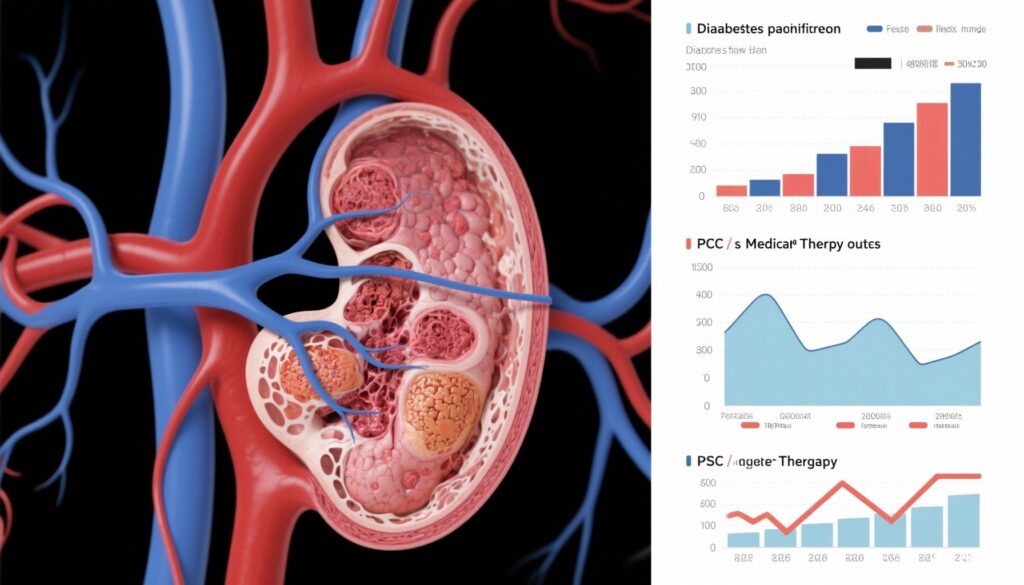Study Background and Disease Burden
Diabetes mellitus significantly elevates the risk of coronary artery disease (CAD) and adverse cardiovascular events. Patients with diabetes often present with more diffuse atherosclerosis and vulnerable plaques prone to rupture leading to myocardial infarction (MI). Although percutaneous coronary intervention (PCI) is well established for flow-limiting lesions causing ischemia, the clinical benefit of preventive PCI targeting non-flow-limiting but vulnerable plaques remains uncertain, especially in diabetic populations. Vulnerable plaques can be identified by intracoronary imaging modalities, yet their optimal management remains unestablished, posing an unmet clinical need to reduce future cardiac events in these high-risk patients.
Study Design
The PREVENT trial (Preventive Coronary Intervention on Stenosis with Functionally Insignificant Vulnerable Plaque) was a randomized, multicenter clinical study enrolling 1606 patients with coronary plaques characterized as vulnerable but non-flow-limiting (fractional flow reserve [FFR] >0.80). Patients were randomized to receive either preventive PCI plus optimal medical therapy or optimal medical therapy alone. Randomization stratified patients by diabetes status (490 patients with diabetes, constituting 30.5% of the cohort). The primary composite endpoint encompassed cardiac death, target-vessel myocardial infarction, ischemia-driven target-vessel revascularization, or hospitalization for unstable or progressive angina over a two-year follow-up period.
Key Findings
The incidence of the primary endpoint was similar between diabetic and non-diabetic patients (1.8% versus 1.9%; hazard ratio 0.98; 95% confidence interval [CI]: 0.45–2.14; P=0.956). Notably, diabetic patients had a higher frequency of PCI for non-target lesions before randomization compared to non-diabetics (40.6% vs. 33.8%, P=0.009), reflecting their higher systemic atherosclerosis burden.
Preventive PCI significantly reduced the primary endpoint at two years in both diabetic and non-diabetic groups. Among diabetic patients, the event rate was 0% with PCI versus 3.7% with medical therapy alone (P=0.004). Similarly, non-diabetic patients also benefited, demonstrating event rates of 0.5% with PCI versus 3.2% with medical therapy alone (hazard ratio 0.16; 95% CI: 0.05–0.55; P=0.004). Crucially, no significant interaction existed between diabetes status and randomized strategy, indicating the efficacy of preventive PCI was consistent irrespective of diabetic status.
Safety outcomes were comparable between groups, with no excess procedural complications or adverse events noted in diabetic patients undergoing preventive PCI. These findings underscore that targeting vulnerable, functionally insignificant plaques can translate into meaningful clinical benefit without increased procedural risk.
Expert Commentary
The PREVENT trial provides robust randomized evidence supporting preventive PCI in diabetic and non-diabetic patients harboring vulnerable but non-flow-limiting coronary plaques. Prior studies have largely focused on ischemia-driven interventions, while plaque vulnerability has been an elusive target clinically. This trial bridges the gap by demonstrating that proactive PCI, guided by intracoronary imaging, can reduce subsequent cardiac events beyond optimal medical therapy alone.
Despite encouraging results, several questions remain. The trial’s follow-up duration of two years, though adequate, necessitates extended surveillance for durability of benefit. Moreover, as the study population is carefully selected with particular imaging criteria and preserved FFR, generalizability to broader diabetic populations with more extensive disease needs further exploration. Furthermore, the biological mechanisms underpinning risk modulation via plaque stabilization through PCI warrant mechanistic investigations.
Conclusion
In patients with vulnerable, non-flow-limiting coronary plaques, the PREVENT trial demonstrated similar adverse event risks between diabetic and non-diabetic patients but confirmed that preventive PCI significantly reduces composite cardiovascular events at two years regardless of diabetes status. These findings advocate for a paradigm shift towards incorporating preventive PCI strategies alongside stringent medical therapy in appropriate patients identified by intracoronary imaging, with a tailored approach that addresses both ischemia and plaque vulnerability to mitigate future cardiac risk.
References
Kim MC, Park SJ, Park DW, Ahn JM, Kang DY, Kim WJ, Nam CW, Jeong JO, Chae IH, Shiomi H, Kao HL, Hahn JY, Her SH, Lee BK, Ahn TH, Chang K, Chae JK, Smyth D, Mintz GS, Stone GW, Ahn Y. Preventive percutaneous coronary intervention for non-flow-limiting vulnerable atherosclerotic coronary plaques in diabetes: the PREVENT trial. Eur Heart J. 2025 Aug 21;46(32):3181-3197. doi: 10.1093/eurheartj/ehaf273. PMID: 40439104.



